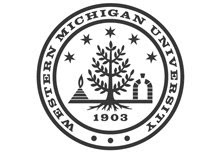Three IME students – all engineering graphics and design technology program (EGR) seniors who graduate in December – accepted an invitation to make a presentation at the CATIA Operators Exchange (COE) Automotive Industry Workshop Technical Conference held last month in Dearborn.
IME students (L–R) Greg Giudici, Josh Brien, and Eric Korbecki
were the only students invited to present at COE conference
In “Putting the Power in Power Copies,” Eric Korbecki, Greg Giudici, and Josh Brien provided an overview of work they did last summer while interning at Johnson Controls, Inc. (JCI). “Our presentation dealt with Knowledge-based Engineering and a form of engineering design in CATIA V5 called power copies,” Korbecki said.
Brien, who interned at the JCI Holland location, explained that “a power copy is a copy of a feature that can be used on a model.”
According to Giudici, who interned at the JCI Plymouth location, the students created power copies as part of the Knowledge-based Engineering (KBE) team at JCI. “Creating power copies saves designers time when they need to use one of the common features,” he said. “Instead of modelling the feature in their part, they simply use the power copy feature.”
For the COE presentation, the students described the processes of creating a power copy, imbedding knowledge into it, and implementing it. Combined with Knowledgeware and engineering rules, a model can be morphed and adapted to its environment. “It’s taking CATIA to the next level,” Giudici said.
According to Korbecki, the students’ design of the workbenches and the applications used were relatively new and advanced. “We considered this an opportunity to show the capabilities of the Knowledgeware workbench in CATIA for rapid and identical creation of common, complex features in a 3D solid model,” he said.
Many concurrent presentations of technical material based on Dassault Systems’ software programs were offered at the workshop. The students’ presentation was part of the Product Design Category at the Beginner, Intermediate level.
“We were the only students to present at this conference,” Korbecki said. “It was a great way to showcase the skills and knowledge we’ve received from Western and from JCI.”
The group credited JCI mentor and KBE team leader Jeff Roark for encouraging the students to speak at the conference. They also expressed their appreciation to JCI co-workers and WMU alumni Dave Burke and Anthony Pulcini for their technical support during the internship.
Attending COE (L-R): JCI’s Jeff Roark, Eric Korbecki,
JCI’s Dave Burke, Greg Giudici, and Josh Brien
In addition to making the presentation, the students also attended presentations on knowledge assets, which is similar to power copies, and product data management (PDM), a virtual data base system. They also participated in a hands-on course for developing 3D solid models at a substantially faster and more efficient rate.
“It was good to get out and see what’s going on in industry,” Brien said.



























